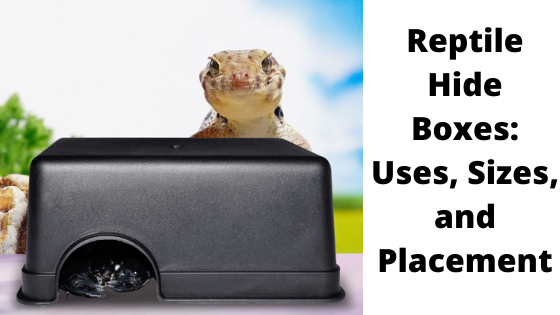A hide box is a very important part of your reptile’s habitat. Reptiles housed without a hide box to retreat to suffer from stress, which leaves them more susceptible to illness. This is because reptiles are not domesticated animals. Regardless of whether or not they were captive bred, they are wild animals that are on the look out for predators, and hiding is a natural part of their behavior. Failing to accommodate this need will result in a sick, stressed reptile.
What are hide boxes for?
You know that hide boxes give your reptile a sense of security, but what exactly are they for? Hides provide reptiles with:
- Secure areas for hiding
- Places to sleep
- Daytime shelters for nocturnal animals
- Outlets for digging
- Places for nesting and egg laying
- The moisture and humidity they need without raising the humidity levels throughout the entire habitat
What should I use as a hide box?
Lizards, snakes, amphibians, and turtles all need at least one hide box in their enclosure. You can purchase a commercial hide, such as the Repti Shelter or Hagen Marina Reptile Décor Cave, or you can make one yourself. Homemade hide boxes can be made from a number of different things, including plastic or cardboard boxes, storage containers, hollow logs, stacked or overlapping rocks, flower pots laid on their sides, and anything else that is large enough for your reptile.
Be sure to use something that is easy to clean and disinfect, as you will have to do that regularly. The hide you choose should have a single entrance, and you may need to put 1″ to 2″ of substrate in it, depending on the species you are keeping and its size.
How big a hide box does my reptile need?
The size of the hide box varies depending on the size of the reptile. Many owners make the mistake of thinking that a bigger hide box is better. In truth, reptiles don’t want a large hide box. To them, a large hide box means that other reptiles (or predators) can fit in the hide with them. The point is to provide a sense of security, and a reptile that has to wonder if something else can get into the hide box with it isn’t going to feel secure.
A properly sized hide box should be just large enough for the reptile to fit in it comfortably, and your reptile should be able to touch the sides of the hide without having to move. Snakes, for example, like hides in which they can touch two or more walls with their sides when they are coiled up. Green Iguanas like hide boxes that just fit the length and width of their body, not including the tail.
The Repti Shelter has three different sizes that may help to give you an idea of how big your reptile’s hide box should be. The 6″ diameter hide is recommended for geckos, anoles, and small lizards and snakes. The 8″ diameter hide is recommended for medium-sized lizards and snakes, and the 12″ diameter hide is recommend for larger snakes such as ball pythons, corn snakes, and kingsnakes that tend to be about 4′ long.
Keep in mind that as your reptile grows, its hide will have to increase in size as well. If you have a juvenile that is growing quickly, you may want to use something like a cardboard box that can easily be replaced until its growth starts to slow.
Where should I put the hide box?
Placement of the hide boxes will vary depending on what animal you are keeping. Arboreal reptiles should have hide boxes higher up in their habitats, while semi-aquatic reptiles will need hides both in the water and on the land area. If your reptile requires a wide range of temperatures in its habitat, you will need to put hide boxes in both the cool side and the warm side of the habitat to allow for proper thermoregulation.
